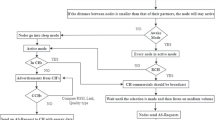Abstract
In wireless sensor networks, one of the main design challenges is to save energy of sensors and obtain long system lifetime without sacrificing the quality of network coverage and connectivity. Topology control is the primary technique of energy saving which consists to keep a minimum number of sensor nodes to operate in active mode with the purpose of conserving energy as well as ensuring network connectivity and/or coverage. In this paper, we propose a Group-based Energy-Conserving Protocol (GECP) for wireless sensor networks that extends the network lifetime by sleep scheduling among sensor nodes with the purpose to ensure the network connectivity. It exploits the sensor redundancy in the same region by dividing the network into groups so that a connected backbone can be maintained by keeping only one active node in each group and turning off the redundant ones. The scheduling strategy, used by GECP, minimizes the number of transitions between sleep and active states in order to minimize the transition energy and the leader election frequency. The simulation results confirm the efficiency of GECP in terms of energy conservation, connectivity guarantee and network lifetime.













Similar content being viewed by others
References
Ababneh, N., Viglas, A., Labiod, H., & Boukhatem, N. (2009). Ectc: Energy efficient topology control algorithm for wireless sensor networks. In Proceedings of IEEE international symposium on a world of wireless, mobile and multimedia networks and workshops (WOWMOM’09), pp. 1–9.
Akyildiz, I. F., & Vuran, M. C. (2010). Factors influencing wsn design. Chapter 3 in Sensor wireless networks. New York: Wiley.
Anastasi, G., Di Francesco, M., Conti, M., & Passarella, A. (2009). Energy conservation in wireless sensor networks: A survey. Elsevier Journal of Ad Hoc Networks, 7(3), 537–568.
Cerpa, A., & Estrin, D. (2004). Ascent: Adaptive self-configuring sensor networks topologies. IEEE Transactions on Mobile Computing, 3(3), 272–285.
Chen, B., Jamieson, K., Balakrishnan, H., & Morris, R. (2002). Span: An energy-efficient coordinator algorithm for topology maintenance in ad hoc wireless networks. ACM Wireless Networks, 8(5), 481–494.
Ding, Y., Wang, C., & Xiao, L. (2009). An adaptive partitioning scheme for sleep scheduling and topology control in wireless sensor networks. IEEE Transactions on Parallel and Distributed Systems, 20(9), 1352–1365.
Frye, L., & Cheng, L. (2009). Topology management for wireless sensor networks. Chapter 2 in Guide to Wireless Sensor Networks. In S. Misra et al. (Eds.), Computer communications and networks (pp. 27–45). London: Springer.
Gengzhong, Z., & Qiumei, L. (2010) A survey on topology control in wireless sensor networks. In Proceedings on 2nd IEEE international conference on futures networks, China pp. 376–380.
Lee, W. L., Datta, A., & Cardell-Oliver, R. (2008). Flexitp, a flexible-schedule-based tdma protocol for fault-tolerant and energy-efficient wireless sensor networks. IEEE Transactions on Parallel and Distributed Systems, 19(6), 851–864.
Marcel, B., Thomas, H., & Wolfgang, E. (2006). Teca: A topology and energy control algorithm for wireless sensor networks. In Proceedings on 9th ACM international symposium on modeling analysis and simulation of wireless and mobile systems (MSWiM’06), Spain, pp. 317–321.
Nan, G., Shi, G., Mao, Z., & Li, M. (2012). Cdsws: Coverage-guaranteed distributed sleep/wake scheduling for wireless sensor networks. EURASIP Journal on Wireless Communications and Networking, 44(1), 1–14.
Nath, S. B., Gibbons, P., Seshan, S., & Anderson, Z. (2004). Synopsis diffusion for robust aggregation in sensor networks. In Proceedings on second ACM international conference on embedded networked sensor systems (SenSys), pp. 250–262.
Rault, T., Bouabdallah, A., & Challal, Y. (2014). Energy efficiency in wireless sensor networks: A top-down survey. Computer Networks, 67, 104–122.
Santi, P. (2005). Topology control in wireless ad hoc and sensor networks. ACM Computing Surveys, 37(2), 164–194.
Sengul, C., Harris, A., & Kravets, R. (2007). Reconsidering power management. In: Proceedings on 4th international conference on broadband communications, networks and systems, BROADNETS 2007, pp. 799–808.
Shih, E., Cho, S., Ickes, N., Min, R., Sinha, A., Wang, A., & Chandrakasan, A. (2001). Physical layer driven protocol and algorithm design for energy-efficient wireless sensor networks. In Proceedings on 7th ACM/IEEE conference on mobile computing and networks (MOBICOM01), pp. 272–287.
Tang, X., & Xu, J. (2006). Extending network lifetime for precision-constrained data aggregation in wireless sensor networks. In Proceedings on 25th IEEE international conference on computer communications (INFOCOM), Spain, pp. 1–12.
Wang, A. Y., & Sodini, C. G. (2004). A simple energy model for wireless microsensor transceivers. In Proceedings on global telecommunications conference (GLOBECOM ’04), pp. 3205–3209.
Wattenhofer, R., & Zollinger, A. (2004). Xtc: A practical topology control algorithm for ad-hoc networks. In Proceedings on 18th international parallel and distributed processing symposium (IPDPS), pp. 216–222.
Xu, Y., Heidemann, J., & Estrin, D. (2001). Geography-informed energy conservation for ad hoc routing. In Proceedings on 7th annual ACM/IEEE international conference mobile computing and networking (ACM Mobicom), Italy, pp. 70–84.
Yin, B., Shi, H., & Shang, Y. (2005). A two-level strategy for topology control in wireless sensor networks. In Proceedings on 11th international conference on parallel and distributed systems, ICPADS2005, pp. 358–362.
Younis, M., & Nadeem, T. Energy efficient mac protocol for wireless sensor networks. In A. Safwat (Ed.), Book chapter in wireless ad hoc and sensor networks. Dordrecht: Kluwer.
Zebbane, B., Chenait, M., & Badache, N. (2013) Gtc: A geographical topology control protocol to conserve energy in wireless sensor networks. International Journal of Trust Management in Computing and Communications, 3/4(1), 320–340.
Zhang, X., Ding, X., Lu, S., & Chen, G. (2009). Principles for energy-efficient topology control in wireless sensor networks. In Proceedings of the 5th International Conference on Wireless Communications, Networking and Mobile Computing (WiCom) (pp. 1–3). China.
Author information
Authors and Affiliations
Corresponding author
Rights and permissions
About this article
Cite this article
Zebbane, B., Chenait, M. & Badache, N. A Group-Based Energy-Saving Algorithm for Sleep/Wake Scheduling and Topology Control in Wireless Sensor Networks. Wireless Pers Commun 84, 959–983 (2015). https://doi.org/10.1007/s11277-015-2670-1
Published:
Issue Date:
DOI: https://doi.org/10.1007/s11277-015-2670-1




